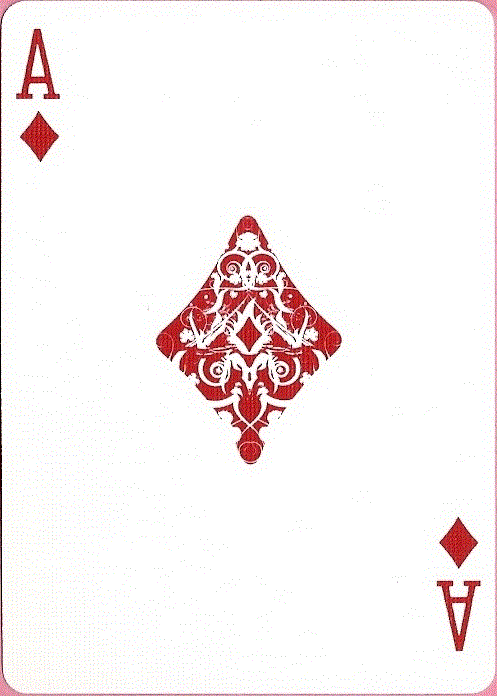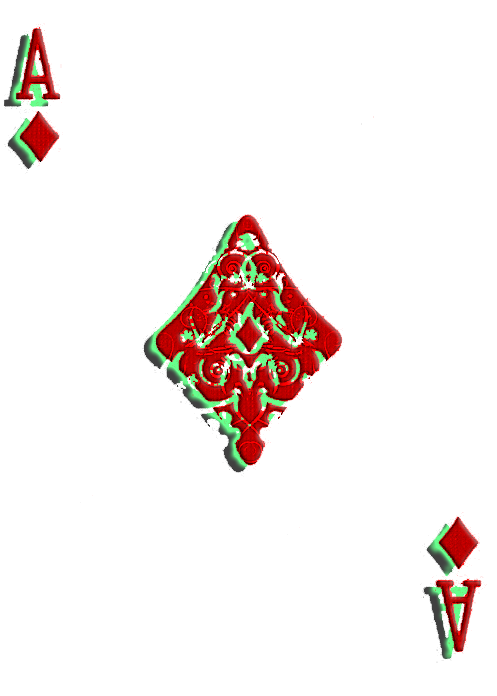 |
 |
This card that I found is a GIF file. |
This is the same card that I edited in |
Diamonds |
|||||
|
|||||
Texas Hold'em is a shared card poker game. Each player is dealt two private cards and there are five face up shared (or "community") cards on the table that can be used by anyone. In the showdown the winner is the player who can make the best five-card poker hand from the seven cards available.
Since the 1990's, Texas Hold'em has become one of the most popular poker games worldwide. Its spread has been helped firstly by a number of well publicised televised tournaments such as the World Series of Poker and secondly by its success as an online game. For many people nowadays, poker has become synonymous with Texas Hold'em.
This page assumes some familiarity with the general rules and terminology of poker. See the poker rules page for an introduction to these, and the poker betting and poker hand ranking pages for further details.
From two to ten players can take part. In theory more could play, but the game would become unwieldy.
A standard international 52-card pack is used.
Texas Hold'em is usually played with no ante, but with blinds. When there are more than two players, the player to dealer's left places a small blind, and the next player to the left a big blind. The big blind is equal to the minimum bet and the small blind is typically half that amount. When there are only two players (a "heads-up" game), the dealer places the small blind and the non-dealer the big blind.
The cards are shuffled and cut, the dealer "burns" one card and then deals the cards one at a time face down until each player has two cards. These are known as the player's hole cardsor pocket cards. Players may look at their two hole cards and must not show them to any other player.
The first betting round is begun by the player to the left of the big blind. The blinds count as bets, so the small blind need only pay the difference between the blinds to call. The big blind player acts last and is allowed to raise, even if the other active players have all called.
After the first betting round the dealer burns one card and deals three cards face up to the table. These three cards are known as the flop. There is then a second betting round begun by the first active player to the left of the dealer seat.
When the second betting round is complete, the dealer burns a card and then deals one card face up to the table. This card is known as the turn or fourth street. There is then a third betting round, again begun by the first active player to the left of the dealer seat.
After the third betting round the dealer burns another card and deals one more card face up - the river or fifth street. There is fourth and final round of betting before the showdown, again begun by the first active player to the left of the dealer seat.
In a fixed-limit or spread-limit game, any betting round that has more than two active players at the start is normally limited to one bet plus three (sometimes four) raises. In the first (pre-flop) betting round the big blind counts for this purpose as the first bet. If a betting round begins with only two active players, there is no limit on the number of raises.
In limit poker, the betting limits are usually doubled before the third betting round. So for example a $10-$20 game would typically have blinds of $5 and $10, bets of $10 in the first two rounds and bets of $20 in the last two.
Active players show their hands in clockwise order, beginning with the who was the last to bet or raise in the final betting round. If everyone checked in the final betting round, the first active player to the left of the dealer seat is the first to show. See the betting and showdown page for further details.
Each player makes the best possible five-card poker hand from the seven available cards: the player's two hole cards and the five face-up table cards, which are known as the board. This can be in any combination: both hole cards with three from the board, one hole card with four from the board, or just the board cards without using the hole cards at all, which is known as playing the board.
Note that:
Example. On the board is ![]() A-
A-![]() Q-
Q-![]() Q-
Q-![]() 9-
9-![]() 6. Player A has
6. Player A has ![]() K-
K-![]() 9; player B has
9; player B has ![]() 9-
9-![]() 6; player C has
6; player C has ![]() 9-
9-![]() 3. This is a three-way tie, since all three players have Q-Q-9-9-A as their best hand. The pot is split equally between A, B and C.
3. This is a three-way tie, since all three players have Q-Q-9-9-A as their best hand. The pot is split equally between A, B and C.